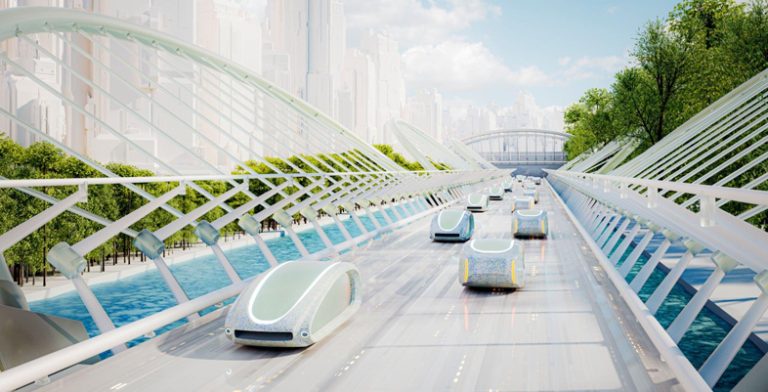The transportation industry is on the brink of a revolution with the rise of autonomous vehicles (AVs). Autonomous vehicles, also known as self-driving cars, are vehicles that can navigate and operate without human intervention. This cutting-edge technology is transforming transportation in unprecedented ways, offering the promise of safer roads, reduced traffic congestion, and increased accessibility for all. In this article, we will explore the various aspects of the autonomous vehicle revolution and its impact on transportation as we know it.
Understanding Autonomous Vehicles
Autonomous vehicles rely on a combination of sophisticated sensors, cameras, GPS, radar, and advanced artificial intelligence (AI) algorithms to perceive their surroundings and make real-time decisions. These vehicles can detect and respond to traffic, pedestrians, and obstacles without the need for human intervention, allowing for fully automated driving experiences.
Levels of Autonomy
The Society of Automotive Engineers (SAE) has defined six levels of autonomy for vehicles, ranging from Level 0 (no automation) to Level 5 (full automation). Level 0 vehicles require a human driver to control all aspects of driving, while Level 5 vehicles are capable of fully autonomous operation without human oversight in any environment.
Safety and Accident Reduction
One of the most significant promises of autonomous vehicles is the potential to improve road safety. Human error is a leading cause of accidents, and AVs can minimize this risk by eliminating factors such as distracted driving, fatigue, and impaired driving. The sophisticated sensor systems of AVs can detect potential hazards more accurately and react faster than human drivers, reducing the number of accidents on the roads.
Enhanced Mobility for All
Autonomous vehicles have the potential to revolutionize mobility for individuals who cannot drive due to age, disability, or other factors. AVs can offer greater independence and accessibility for seniors and people with disabilities, providing them with newfound freedom to travel and access essential services.
Traffic Congestion and Efficiency
With advanced traffic management systems and real-time data analysis, AVs can optimize traffic flow and reduce congestion. By communicating with each other and traffic infrastructure, AVs can make intelligent decisions to avoid traffic jams and select the most efficient routes, leading to smoother traffic flow and reduced travel times.
Eco-Friendly Transportation
As the world becomes increasingly focused on sustainability, AVs can contribute to eco-friendly transportation. Electric autonomous vehicles can reduce greenhouse gas emissions and air pollution compared to traditional internal combustion engine vehicles. AVs can also promote more efficient driving patterns, conserving energy and minimizing the overall environmental impact of transportation.
Public Transit and Shared Mobility
Autonomous technology extends beyond personal cars to public transit systems and shared mobility services. AVs can be integrated into public transit networks, offering more flexible and on-demand transportation options. Shared autonomous vehicles can also reduce the need for individual car ownership, leading to fewer vehicles on the roads and less urban congestion.
Urban Planning and Infrastructure
The widespread adoption of AVs will affect urban planning and infrastructure design. Cities will need to adapt their road networks, parking facilities, and traffic signals to accommodate the unique needs of autonomous vehicles. Well-designed AV infrastructure can enhance safety and efficiency while creating more pedestrian-friendly urban environments.
Ethical and Legal Considerations
As AV technology progresses, ethical and legal considerations arise. Questions about liability, decision-making in critical situations, and data privacy must be addressed. Policymakers and regulators are working to establish appropriate legal frameworks and safety standards to ensure the responsible deployment of autonomous vehicles.
Challenges and Barriers
While the potential benefits of autonomous vehicles are promising, several challenges and barriers must be overcome. Technological limitations, public acceptance, cybersecurity concerns, and the need for extensive testing and validation are among the AV industry’s key challenges.
Transition Period and Coexistence with Conventional Vehicles
The transition to a future dominated by autonomous vehicles will not happen overnight. During the early stages, autonomous and conventional vehicles will need to coexist on the roads. This transition period poses unique challenges, including potential interactions between human drivers and AVs. Strategies for ensuring safe coexistence and educating the public about interacting with autonomous vehicles will be essential during this phase.
Impact on Employment and Workforce
The widespread adoption of autonomous vehicles could have significant implications for employment and the workforce. As AVs replace traditional driving jobs, such as truck drivers and taxi drivers, there may be disruptions to the labor market. Policymakers will need to address these workforce changes and implement measures to support affected workers through reskilling and upskilling programs.
Data Privacy and Cybersecurity
Autonomous vehicles rely heavily on data collection and communication between vehicles and infrastructure. Ensuring data privacy and cybersecurity will be critical to safeguarding sensitive information and protecting AVs from potential cyber-attacks. Robust cybersecurity measures and encryption protocols will be essential to maintaining public trust and confidence in AV technology.
Adoption in Developing Countries
The adoption of autonomous vehicles is likely to occur at a different pace in developing countries compared to developed nations. Factors such as infrastructure readiness, affordability, and regulatory frameworks will influence the deployment of AV technology in these regions. Addressing the unique challenges faced by developing countries will be vital to ensuring equitable access to the benefits of autonomous vehicles.
Interconnected Transportation Ecosystem
Autonomous vehicles are part of a larger, interconnected transportation ecosystem. AVs will interact with various stakeholders, including pedestrians, cyclists, public transit systems, and other road users. Coordinating these interactions and integrating AVs seamlessly into existing transportation networks will be crucial for maximizing the benefits of autonomous technology.
Public Acceptance and Trust
Public acceptance and trust are essential factors in the successful integration of autonomous vehicles into society. Building trust among the general public requires clear communication about the benefits of AVs, safety records, and transparency about the technology’s limitations. Demonstrating the safety and reliability of AVs through rigorous testing and pilot programs can help foster public confidence.
Cross-Border Collaboration and Standards
As autonomous vehicle technology crosses international borders, cross-border collaboration and the establishment of global standards become necessary. Harmonizing regulations and safety standards among different countries will facilitate the deployment of AVs across multiple regions, enabling smoother cross-border transportation and international cooperation.
Vehicle-to-Everything (V2X) Communication
Vehicle-to-everything (V2X) communication is a crucial aspect of autonomous vehicles’ capabilities. V2X technology allows vehicles to communicate not only with other vehicles (V2V) but also with infrastructure (V2I) and pedestrians (V2P). This communication enhances situational awareness and safety, enabling AVs to anticipate potential hazards and make informed decisions.
Environmental and Energy Impact
While electric AVs contribute to reducing greenhouse gas emissions, the overall environmental impact of autonomous vehicles must be considered holistically. Factors such as manufacturing, infrastructure construction, and the disposal of AVs at the end of their life cycle should be evaluated to understand the technology’s true sustainability benefits.
The Future of Transportation
The rise of autonomous vehicles marks a pivotal moment in the future of transportation. As AV technology continues to evolve and become more widespread, its impact on society, mobility, and urban planning will be profound. The journey toward a fully autonomous transportation landscape will be characterized by continuous innovation, collaboration, and adaptability as we embrace the transformative potential of autonomous vehicles.
The emergence of autonomous vehicles represents a monumental shift in the transportation landscape. From technological advancements and safety considerations to ethical dilemmas and global collaboration, the AV revolution encompasses a vast array of complexities and possibilities. Addressing the challenges and maximizing the benefits of AV technology requires cooperation among governments, industry leaders, researchers, and the public. By navigating this transformation thoughtfully and responsibly, we can build a future where autonomous vehicles coexist seamlessly with other modes of transportation, delivering safer, more efficient, and sustainable mobility for all. The journey toward this future has only just begun, and the continuous evolution of autonomous vehicle technology promises a transportation landscape that is safer, greener, and more accessible than ever before.






